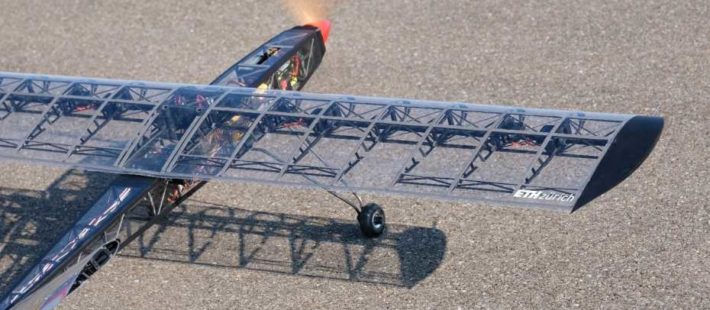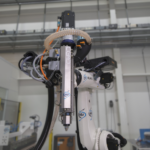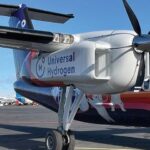During its maiden flight, the morphing aircraft developed by Leo Baumann, proved its flight capabilities. The aircraft was manufactured from 3D printed composites as a collaboration of the CMASLab at the ETH Department of Mechanical and Process Engineering and the ETH Spin-off 9T Labs.
For any aircraft, a substantial part of the drag can be attributed to the control surfaces on the wings. When the surfaces are deflected, the airfoil shape changes and leads to higher drag. In consequence, the engine requires more power.
The research group of Paolo Ermanni at the Composite Materials and Adaptive Structures (CMASLab) has investigated aerodynamically efficient aircraft wings using compliant structures, so called morphing wings, for the last 12 years. In this context, the Master’s student Leo Baumann, in collaboration with the ETH spin-off 9T Labs, has investigated the possibility to 3D print lightweight and selectively compliant composite structures. With the supervision of the doctoral students Dominic Keidel and Urban Fasel, the team developed a wing with a continuous skin and a morphing structure, which has highly adaptive and aerodynamically efficient control surfaces reducing the aerodynamic drag.
To proof the structural performance of the morphing wing, and to analyse the flight characteristics of the aircraft, the team developed a morphing composite drone. To achieve the desired trade-off between stiffness and compliance, the team used a 3D printer developed by 9T Labs, which enables the manufacturing of parts consisting of both plastics and carbon composites. All structural components of the drone were realized with 3D printing, except for the wing skin and the electronics. The manufacturing process and the flight tests were published by the team in the Journal of «Manufacturing Letters».
Many advantages
The advantage of the manufacturing methods is that the carbon fibres can be aligned to achieve the desired characteristics of the part. By aligning the fibres with the load paths, the anisotropy of the material is optimally exploited. By printing complex geometries with less waste material, the parts could be manufactured at lower cost compared to conventional manufacturing methods. Furthermore, the team reduced the complexity and part count through designing the aircraft with the manufacturing method in mind. The printing process is repeatable and easily adaptable, which allows multiple iterations of a part and fast fabrication of spare components.
Manufacturing and testing
The drone was manufactured in individual components, with the main structural parts of the wing, fuselage and V-Tail being printed on the 3D printer of 9T Labs. The lattice structure of the wing then was covered with a thin skin. This combination of a load-carrying internal structure and the aerodynamically smooth surface leads to an efficient, light-weight aircraft. Both the plastics and composite parts are based on thermoplastic materials, which enables the reheating and welding of the structure. This could be used to assembly the final structure without requiring any additional adhesive.
Both the wing and the V-Tail rely on the same morphing concept to achieve control around the pitch, roll, and yaw axes. The control surfaces on the wing are actuated by eight servo motors, which enable a maximum trailing edge deflection of 48 mm. By individually controlling the deflection of each motor, the lift along the span can be varied, reducing the structural loads and potentially increasing the efficiency of the drone.
A three-minute maiden flight showed ample control of the aircraft through morphing. Not only the main wing, but also the V-tail performed excellently, achieving full control around the roll, pitch, and yaw axis. Different manoeuvres, including barrel rolls and loopings could be flown, showcasing the versatility of the aircraft.
Source : EHT Zürich
Pictures
On the top : Morphing aircraft, manufactured through additive manufacturing of composite materials, ready for take-off
On the bottom : Drone showing the deformed main wing













